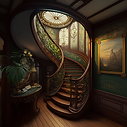The interior design industry started about 100 years ago with the growth of middle-class society and the elaborate architecture that became popular during the industrial revolution. Interior design is all about making the inside of a space look better and more appealing. An interior designer is a trained professional who can plan, research, coordinate, and manage decor projects. Designers have a deep understanding of the history of interior design, including the roots of different design styles and elements. Our timeline provides a brief overview of the interior design history.
INTERIOR DESIGN HISTORY TIMELINE

-
Aesthetic Movement 1800’s to Today
The Aesthetic Movement, focused on "art for art's sake", was a rebellion against conventional interior design. Practicality and function were prioritized over beauty, reflecting the radicals' dissatisfaction with current design trends.

-
Tuscan 1840’s to Today
Inspired by the tranquil charm of Tuscany, interior designs during this period was characterized by simple elegance with touches of luxury.

-
Arts & Crafts 1860 to 1910
To protest against mass-produced items brought about by the Industrial Revolution, people turned to traditional crafts and classic elements to create furnishings.

-
Rustic 1870’s to Today
Rustic interior design is defined by handmade furnishings and large rooms with wooden beams and columns. It combines cozy, unpretentious design with practical functionality, using natural materials as the foundation for creating a warm and beautiful space.

-
Modernism 1880 – 1940
Modernist design emphasized simplicity and clarity, rejecting ornamentation. Notable figures of the movement include Mies van der Rohe, Le Corbusier, and Eero Saarinen, whose iconic works like the Saarinen table and chair embody the style.

-
Art Nouveau 1890 to 1920
The Art Nouveau movement was driven by a passion for natural silhouettes and botanical elements, resulting in its signature curved lines and organic shapes.

-
Colonial Revival 1905 to Today
Inspired by Neoclassical and Georgian styles, the Colonial Revival was popular in the U.S during the centennial. The style was widely popular until WWII and some attribute its popularity to the launch of the automobile, as people were able to easily visit historical landmarks.

-
Eclectic 1900’s to Today
Eclectic style is a mix of various design styles and is becoming popular, leading to an increase in interior designers. It involves harmonizing different styles, textures, and colors to create a beautiful room. This style is about experimentation and having fun with design, so embrace its freedom.

-
Mid-Century Modern 1930’s to Today
The mid-century modern era encompasses post-WWII practicality, 1950s optimism, 1960s earthiness, and 1970s textures and tones, all featuring a minimalist, Scandinavian-inspired aesthetic. It's a fresh and lively, retro-inspired style that combines comfort and functionality with timeless design. The exact timeline of the term is unclear, but it wasn't officially coined until the mid-1980s.

-
Surrealism 1925 to 1930
Surrealists such as Salvador Dali, André Breton, and Max Ernst aimed to challenge traditional design norms and bring a sense of unpredictability to art, music, interior design, and more through their avant-garde style.

-
Mediterranean 1920’s to Today
To evoke a coastal European feel, interior design relied on terra cotta, stone, patterned tiles, wrought iron, and aquatic color hues.

-
Art Deco 1920’s to 1960
Art Deco is a mix of early 20th century design styles, including Constructivism, Cubism, Modernism, Bauhaus, Art Nouveau, and Futurism. Known for its glamor and elegance, Art Deco features clean lines, angular shapes, bold colors, stylized patterns, ornate embellishments, and metallic surfaces. It's a well-known interior design style that symbolizes modernity and everyday glamor.

-
Country 1920 to 1970
Country style in interior design was characterized by practical furnishings inspired by traditional farmhouses. Today's modern country style is a classic blend that incorporates playful and subtle elements while still retaining a nod to its roots.

-
Bauhaus 1920 – 1934
Founded by Walter Gropius in Germany, Bauhaus is revered for its minimalist and masterfully crafted design style, and produced many influential architects, artists, graphic designers, furniture makers, and innovators of the mid-20th century through the Bauhaus school of art and design.

-
Modern 1918 to 1950
With a focus on sparse interiors and bold primary colors, Modern interior design eschewed the typically ornate and over decorated design aesthetic trending at the time.

-
Tropical 1880’s to Today
During the British empire's expansion into India and the West Indies, they merged interior design elements from both their home country and occupied territories, creating a unique blend of traditional and exotic styles.

-
Neoclassical Style 1780 to 1880
This era drew inspiration from ancient Greek and Roman cultures for architectural details and motifs. Furnishings heavily utilized bronze and gold metals and incorporated soft materials such as silk, velvet, and satin. The trend of coordinating wallpaper and furnishings also emerged.

-
The Industrial Revolution 1760 to 1820
During the Industrial Revolution, interior design became more accessible to the general public due to improved printing methods that led to wider distribution of fashion and lifestyle publications and increased availability of luxury items.

-
Rococo 1700
Rococo interior design was a highly elegant and intricately detailed style inspired by botanical silhouettes. It incorporated unique elements such as tortoise shell and pearl accents and Asian porcelain.

-
Traditional 1700 to Today
Traditional interior design remains popular with a formal spirit. It encompasses many styles and movements, not confined to one direction or essence. It blends past and present, inspired by 18th and 19th-century European decor, offering timeless glamor and comfort. Ideal for those who love antiques, classic art, symmetry and historic design.

-
Baroque 1590 to 1725
Sumptuous interior designs were created with ostentatious, ultra-rich elements such as stained glass, twisted columns, colored marble, painted ceilings, gilt mirrors, and oversized chandeliers.

-
Gothic 1140 to 1400
After the Dark Ages, bold colors and decorative elements returned to prominence in interior design. The era's two lasting impacts are the use of more windows for brighter homes and open floor plans.

-
The Renaissance Period 1400 to 1600
Interior design flourished during the Renaissance, with grand furnishings and artwork in rich colors, luxurious textiles like silk and velvet, and marble surfaces. Carpets were expensive, so they were used as wall art when possible.

-
The Byzantine Empire 500 to 1500
During this time, grand domes and extravagant decorations were the focus.

-
The Dark Ages 900 to 1500
During the Dark Ages, interior design was not a priority and people chose simple wooden walls, limited furniture, and stone flooring.

-
Roman Empire 753 BC to 480 AD
During a time when royalty couldn't show their wealth through their homes, the Romans used murals and mosaics for decoration and had furniture with clawed feet.

-
Greek Empire 1200 to 31 BC
For the first time, people began decorating their homes with their own unique style as civilization and lifestyles advanced. Wealthy Greeks had furniture with intricate ivory and silver inlays. Pillars and columns were important design elements and the Greeks established building standards.

-
Ancient Egypt 2700
When royalty gained power, people started living in buildings other than mud huts. These new homes had paintings, vases and sculptures that showed their history and beliefs.

-
Neolithic Europe 2000 to 1700 BC
The first recognizable handmade pottery was created, serving both practical and ornamental purposes.

-
Stone Age 6000 to 2000 BC
The earliest evidence of interior design can be found in prehistoric dwellings made of mud, animal skins, and sticks.

-
Scandinavian 1930’s to Today
The Scandinavian interior design movement, part of modernism, emphasizes functional, simple, and affordable design using natural materials like leather, wood, and hemp. It also reflects a connection to nature through use of natural shapes, abstract forms, and natural elements. The movement's popularity continues due to its practical yet beautiful designs.

-
Transitional 1950’s to Today
The television revolutionized interior design by influencing home decor choices. Transitional style combines traditional and modern elements for versatile and effortless home decoration. It encompasses a blend of various design styles, creating a unified look in a single space.

-
Postmodernism 1978 – Today
The Postmodern design movement arose as a response to the perceived monotony of Modernism. Ettore Sottsass, an Italian architect and designer, was a key figure in the movement, known for his vibrant shapes, patterns, and use of bold colors.

-
Contemporary 1980’s to Today
Contemporary interior design is a timeless blend of classic and modern styles, featuring a minimalistic approach to decor. Unlike modern decor, contemporary style offers a warm and serene atmosphere, accentuating architectural elements, bold scales, and a limited color scheme. Simplicity, clean lines, textural elements, and understated elegance are essential to achieving a harmonious contemporary home.
Homework
Now you know the difference between Modernism and Modern, Art Nouveau and Art Deco. In addition, watch our playlist with the most recommended documentaries about interior design and architecture.
